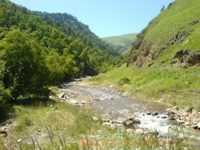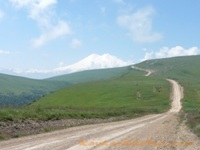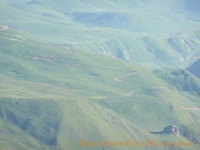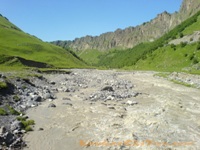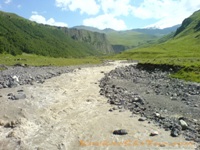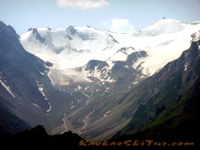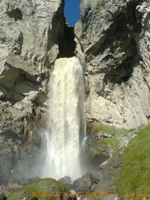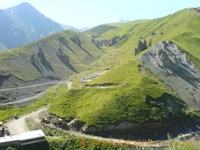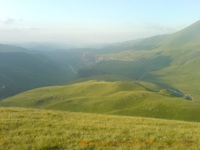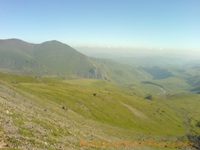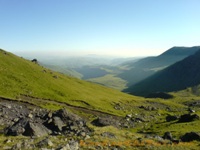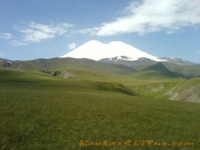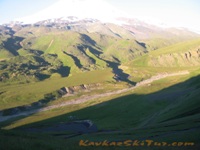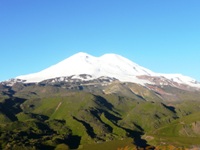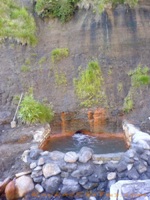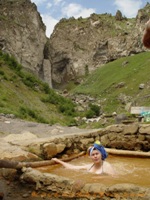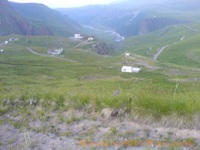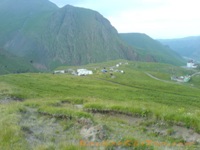The road to Elbrus North is one of the most difficult and exhausting. To be more exact there was no road at all up to 1980-s. Now there are two roads leading there from two different sides of Malka canyon but they still remain tiresome.
After about 40 km of federal road from Nalchik in the diraction to Min Vody we turn from the main road in village Malka to canyon Malka. The comfortable road goes again about 40 km up till village Kichmalka in a good condition. From here starts the difficult path till north base camp of Elbrus.
Following the stream of the river Kharbaz, we reach the river Khasaut and the tourist camp “Valley of Narzan” reminding of an old castle by its form. It is not lived in now. There are 14 natural mineral springs here: each has its own specific qualities which are superb. From here we drive 10 km more till the base camp.
On the way after the Valley of Narzan there is the place we can see one more wonder of Elbrus Country – megaliths. There are several megaliths. Most of them are about three meters high. Its upper part is made like the warrior’s head in helmet. Megaliths is one of the most puzzling mysteries here.
You can get a lot of very interesting information about European megaliths in the WEB but not about Caucasian ones. Judging by the peculiarities of graving we can detect here the traditions of fore-Asiatic and Cimmerian art. This monument – if to judge by the features – may be referred to Scythians. As for the helmet it is the so called Assyrian type. It means that the monument goes back to the beginning of the 7th century BC.
There are megaliths in other parts of Kabardino-Balkaria, too. For example, one megalith of improbable size was found in the canyon Tuuz-Sirt, to the south-east from village Nizny Chegem. Another one is a graven image of some ancient deity or animal made from the whole block of granite.
Approaching Gili-Su (2380 m) through the plateau with the watershed of the rivers Ingushly and Malka – you’ll get a marvelous view: Rocky Range with two beautiful summits of Western and Eastern Kandjol.
Nowadays it is generally accepted that the formation of Elbrus volcano and its activity began about 4 million years ago and was over about 4,5 -5 thousand years ago. Elbrus is an inactive volcano but some volcanic processes are still going on that can be detected by the temperature of water from the mineral springs (up to 24 grades C). Gili-Su springs are among them.
Gili-Su is a combination of numerous wonderful phenomena among which mineral springs giving power, energy, health; surprising ancient burials; mysterious megaliths; lakes on the mountain slopes; grand waterfalls; amazing views and a lot of other things. There is even something dealing with the riddles of the recent history: top secret aerodrome of the 2-nd World War..
We may say that Gili-Su is first of all is the creation of Elbrus as it is situated on its northern slope and is inspired by its might.
Only three mineral springs were known up to 1909. Afterwards a powerful landslide closed their out¬lets. One of the springs disappeared at all as Malka made there its bed. Nowadays we know about several mineral springs in different parts of Gili-Su. One of them is warm (22,4°C). It makes a reservoir with a brook going out of it. Two springs – 120 meters below Gili-Su – are on the banks of Sultan-Gara-Su river. They are often called Misost-narzan after the name of the man who showed the springs to the researchers. The last one – 3,5 km further from the main spring – somewhere below the mouth of Kara-Kaya-Su river.
Just near the springs there is a grand waterfall Sultan – an amazing natural monument (35-40 meters high). River Kizil-kol precipitates down from a great height joining the water of river Birghanli-Su at the outlet of the warm mineral springs. A bit further there is one more waterfall – impetuous current falling into the narrow canyon from the height of 27 meters.
One more surprising masterpiece of nature is just behind the waterfall Sultan. It is a stone bridge across the river. Standing on it you experience different – from awe to rapture – feelings caused by a ferocious, wild power of the stream below.
Here is an extract from the book of 1913 by a famous traveler S.Anisimov: “One of the biggest glaciers of Elbrus Ullu-Chiran has one of the most original bridges in the world: it is a huge fallen fragment of rock which narrowed the flow of river Malka turning it into a passage. Malka rages and roars under the bridge but all around there are plenty of blue, white, violet alpine flowers. The stream of Malka, tearing out from volcanic rocks at the height of 40 meters, falls down becoming a striking waterfall with clouds of rainbow-like splashes” (Anisimov A. Kabardino-Balkaria. M., 1937).
Above the springs an astonishing prospect at the valley of Malka river.
It’s nice to make a camping near the Dgilisu springs. Near the narzan bathes two rivers – Birdgalisu and Kyzyl-Su that are the sources of the river Malka flow together. We cross over the bridge to the left bank and go along the good path to the mouth step of the high-mountain valley of the Kyzyl-Su River (40 minutes). From here you can see the legendary Elbrus. The mountains around Elbrus seem the hills from here. The Elbrus Slopes are the sources of the rivers of the Malka basin. The square of the contemporary Elbrus glaciers is more than 135 square kilometers.
Further on there is the most highland (2598 m above sea) plateau Irakhin-sirt. It is the place where in 1829 the above mentioned expedition of Georgy Emmanuel (the hero general of the Patriotic War of 1812) pitched the camp. The purpose of the expedition was to “obtain a true information about this country: its mountains, valleys, canyons, woods, pastures, mineral springs and other phenomena of nature…”
The personnel of the expedition was 350 Cossacks, 650 soldiers, 2 cannons, 6 camels with Kalmuck drivers and two native guides – Islam Krimshaukhal and Mirza-kul Urusby. The general Emmanuel invited some scientists from The Russian Imperial Academy, the architect Bernardacci and Hungarian traveler Besh (Bess’e) to take part in the researches.
As Yanosh Besh put it down, “the expedition is a symbol of unity of the aim notwithstanding the variety of people and sciences. 9 nations from Europe and Asia take part in this undertaking. We are the first to look at Elbrus”.
The path leads to the summer farmyard situated near the Emmanuel’s Rock, on which you can see the inscription in the memory of the first Elbrus ascent: “From 8 to 11 of July in 1829 the general of cavalry Emanuel had been camping here”. This inscription was discovered by chance in 103 years after by the expedition as the layer of lichens covered it.
The Dgilisu valley (“Warm Waters”) is known as a public balneological health resort. Long since the mountaineers knew about the medicinal properties of these mineral springs and used them. Now the Dgilisu springs are two thick springs with pools for the bathing with the constant temperature of water 22.4 degrees above zero. In spite of ways difficulties, high altitude (2,380 meters) nearness of Elbrus glaciers and the primitive state of life and treatment the resort visitors always get easing here.
A healing, curative power of Gili-Su springs seems unbelievable: their water cleanses the organism from slags; induce inner energy; rise life tone; improve general state; make your sight sharper. Gili-Su is not only mineral healing springs but a wonderful microclimate as well. It is a kind of natural inhaler. Air there is absolutely pure. You can’t but enjoy it.
But the main wonder of this place is, of course, Elbrus. It is beyond comparisons, above understanding. Matchless. Elbrus is tender pink at dawn, dazzling white – at noon, bluish black – at midnight. Ancient and newly-born, constant and changing, calm and challenging…
One of its “minor” wonders is Gili-Su – a masterpiece of nature. We can’t help admiring it. We can not even enumerate all its peculiarities. Here are only some of them: lava dike in the valley of river Karakaya-Su; the moraine glacier deposits; 20 meters high ice wall on the tongue of the glacier Ullumalienderku; ice plateau with the peak of Kalitsky; the glacier Mikelchiran going down right into the lake…
We can only mention here some ancient inscriptions on the rocks of the northern slopes of Elbrus accessed to the people of those days; of the caves containing family burials; of some burials where remarkable skulls – “unusually long, with big foreheads” – were found. By the way, there are only three places in the world with the finds alike: they are in Peru, Egypt and Siberia.
Gili-Su may be really called a splendid mystery itself.


 +7 928 691 44 05
+7 928 691 44 05 
 Russia, KBR, city Nalchik
Russia, KBR, city Nalchik











